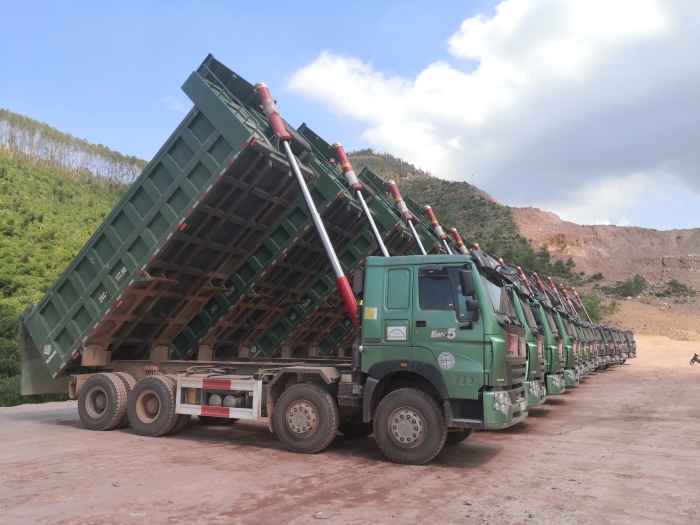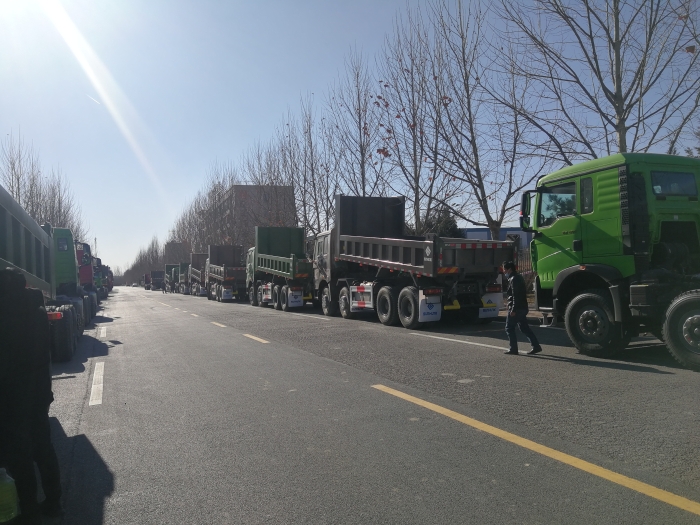- PRODUCTS
- SOLUTION
- SERVICE
- NEWS
- ABOUT US
Coal mine trucks enhance mining efficiency by reducing transportation times by up to 35%, increasing load capacity by 100%, and utilizing advanced technology to minimize downtime.
In the mining industry, coal mine trucks are at the forefront as they enhance operational efficiency. These transportation vehicles are truly not what they seem as they are more of a mechanical behemoth. Standing as a backbone, these trucks provide the seamless operation of transferring coal and carry a substantial impact on this industry. Indeed, the technology of the twenty-first century speeds up the process of coal transportation and increases load capacity and reduces retention period.
In terms of reducing the time it takes to transport coal, coal mine trucks are truly a miracle. Often reaching over 2,500 horsepower and able to contain over 400 tons of coal, these vehicles move heavy loads at lightning fast speeds. In fact, a study by the Energy Information Administration estimated that transportation by trucks could reduce the delivery time of coal by at least 35%, unlike traditional rail systems . Additionally, the coal mine trucks use embedded navigational and monitoring technologies that ensure the optimal use of the mine’s streets and roads. As such, all coal is transferred with the minimal amount of time that could be taken on one trip. This means that the number of travels per day can be increased, which naturally leads to lawmakers meeting their production quotas for the day.
Driving forces also engineered the design of the trucks in such a way that the load capacity is vastly enhanced while maintaining its efficiency and speed. In fact, the trucks have special beds that are constructed to be as high as possible without sacrificing the stability of the overall truck. Moreover, these trucks are still efficient and easily maneuverable, which dramatically improves the load capacity of the required equipment in a single trip.
Mines can halve the number of trips necessary to carry the same amount of coal by doubling the load capacity from what used to be an industry standard of 200 tons to 400 tons or more, . Such an opportunity is highly efficient. This allows managers to save significant amounts of fuel as well as to extend mine road and truck life. Finally, lower frequency of trips contributes to considerable cost savings. Cutting downtime through advanced truck technologies Downtime is a serious issue in mining because every minute of non-action results in losses in revenues. Coal mine trucks are now equipped with predictive maintenance technology, which, having been tested by the Mine Safety and Health Administration, has decreased overall downtime by “up to 20%” . Tires have also been engineered to last longer and be more sustainably used in the mining environment. Driving in rough conditions, trucks must have suitable tires that last for long and can be changed less frequently. Conclusion- coal mine trucks play a crucial role in making mining processes more efficient. As it is evident from the above, their contribution in terms of speeding up transportation, increasing load capacity, and cutting downtime is significant. Technological advancements now enable managers to minimize the time coal mine trucks spend in rather than viable bays, increasing their time of productive use. In the contemporary business environment, where the demand for coal fluctuates significantly based on market trends and overall economic performance, more efficient mining is the key to preserving the coal industry as such.

The strategic use of trucks allows optimizing coal mining processes and significantly enhancing operational efficiency and reducing costs. Its success is attributed to two fundamental approaches: integration with mining equipment to ensure seamless operations and precision in navigation and dumping to save time.
To ensure integration with other mining equipment and enhance operational efficiency, trucks are synchronized with excavators and loaders. A real-time communication network is established to guarantee that trucks are wherever they need to be in the mine. In addition, such systems assigning the trucks use algorithms aimed at choosing the closest vehicle accepting material to be transported and the best truck to perform loading . A mine implementing an automated dispatch system to facilitate this integrated approach reports a 10% increase in efficiency of the trucks because the system chooses the most optimal paths allowing vehicles to consume less fuel to cover distances and diminish time. Finally, a failure to address a problem of unsynchronized operations is downtime because of trucks’ and critical machinery being critically out of order simultaneously.
The other element of dispatch facilitating seamless integration is the use of predictive analytics for maintenance. The problems can be identified and addressed before they result in issues through trucks with sensors, collecting a wide array of data in real-time and transmitting it to the mainframe used to create predictive models. The root of most of them can be traced back to the engine of the vehicle, so the sensors track engine performance, fuel consumption, and tire pressure .
For leading precious minutes and seconds there should be a precision in both navigation and dumping . GPS and RFID technology inside the trucks are used to let the vehicles choose the best roads in the mine . According to the National Mining Association , the travel time can be decreased by 20% under such systems. For dumping, there should be a precision to perform it quickly and appropriately. Such systems indicate not only the precise dumping locations but also the current state of the site to ensure the material can be accepted. It is important on big sites with a risk of overloading, since the operators will not be allowed to replace the mass on them with new material until it is moved elsewhere. Apart from that, drones have started being used to indicate the best places on dumping sites to deposit a mass. This can decrease the amount of the time spent for dumping by 15%, as well as optimize the use of space potential and reduce the need to move the material after some time.
The shift to fuel-efficient engines among coal mine trucks has a significant impact on operating costs and emissions. Essentially, such engines are optimized for maximum power output and minimal fuel consumed during operation. For example, the latest fuel-efficient engines can reduce fuel consumption by about 20% compared to traditional engines without reducing performance . This achievement is primarily enabled by advanced combustion technologies, aerodynamic designs, and lightweight materials. Specifically:
Optimization : These fuel-efficient engines are more optimized to ensure more complete combustion and less wastage and emissions during the power generation process;
Aerodynamics : The new trucks are more aerodynamically designed with obvious features for reducing air resistance. Reducing the energy otherwise consumed to keep the truck at a constant speed and using such energy to gain speed has reduced fuel consumption significantly;
Use of lightweight materials : The trucks are constructed with high-strength steel and composites, creating a lightweight truck that maintains structural strength. Reducing the weight reduces the energy demand for operation and hence reduced fuel consumption and combustion. Eco-friendly practices and operation
Alternatively, eco-friendly practices in truck operations have also generated fundamental benefits in energy consumption and emission. Such practices may involve:
Driving : Some drivers get in-house training in the proper driving techniques through the gears to reduce fuel consumption . The training may involve minimizing unnecessary stoppages, gentle acceleration, and constant speed on long stretches of roads. Ideally, the eco-driving technique can help in reducing fuel consumption as much as 10-15%.
In the world of coal mining, which is both fiercely competitive and resource-intensive, the pursuit of truck efficiency is not only a matter of utilizing the latest technology. Rather, truck efficiency in this context consists of two distinct strategies, both of which have proven to be indispensable. These are scheduling and routing optimization, as well as continuous performance monitoring and maintenance. Each of these strategies has its own unique benefits, but the overall effect of such optimizations is that a fleet is used in a maximally efficient manner. Thus, these techniques produce substantial cost and productivity benefits.

Scheduling and routing optimization in coal mining relies on modern algorithms and real-time data to determine the most efficient use of trucks. Such strategies not only balance the demand for trucks across different jobs at a coal mine but respond dynamically to the changing circumstances. Such factors as the overall scale of traffic within a mine, the relative availability of various machines or stations needed to service a truck, and changes in demand can alter the balance of ITVs throughout an operation. The benefits of such techniques include:
better truck utilization. This is not only a matter of never letting a truck remain idle when it could be carrying a load, but also of ensuring that the truck is en route to or located at the most direct location for its next job. Estimates suggest that such routing optimization can reduce the size of a fleet by roughly 5-10% without impacting production volumes.
reduced fuel costs. The more optimized the route, the shorter the distance that the truck needs to travel and the less that it needs to idle. Various reports from mining operations suggest that fuel savings resulting from routing optimization can amount to 5-15%.
reduced wear and tear of vehicles. Minimizing the number of units required and the distance which they must travel extends their working life, which is directly relevant to costs.
For such strategies to be implemented, dispatchers need to have an efficient software package that processes a vast amount of real-time data and provides them with prescriptive actions. Such solutions are becoming more and more sophisticated, and some of them rely on AI to learn from historical data and improve recommendations.
Continuous performance monitoring relies on sensors and IoT devices to collect data about every facet of a truck’s operation. Predictive analysis using the resulting stream of data serves two main purposes:
Predictive maintenance. Pre-emptive interventions to replace failing parts ensure that the truck is only out of service for as long as it takes to return it to full capacity. Some studies suggest that predictive intervention can reduce maintenance downtime by as much as 20-30%, and substantially reduce total costs.
overall operational efficiency. Continuous monitoring can also identify patterns that need to be addressed by changes in practice. The estimates of the improvement in efficiency that such systems enable are in the range of 5-10%.
For such changes to be effective, it is crucial that real-time data is integrated into the daily practice by the maintenance teams. As can be seen, the two such strategy types intertwine and form a single whole system with distinct, yet complementary beneficial effects. The implementation of each of these strategies as essential operational processes is the key to improving truck efficiency in coal mining operations.